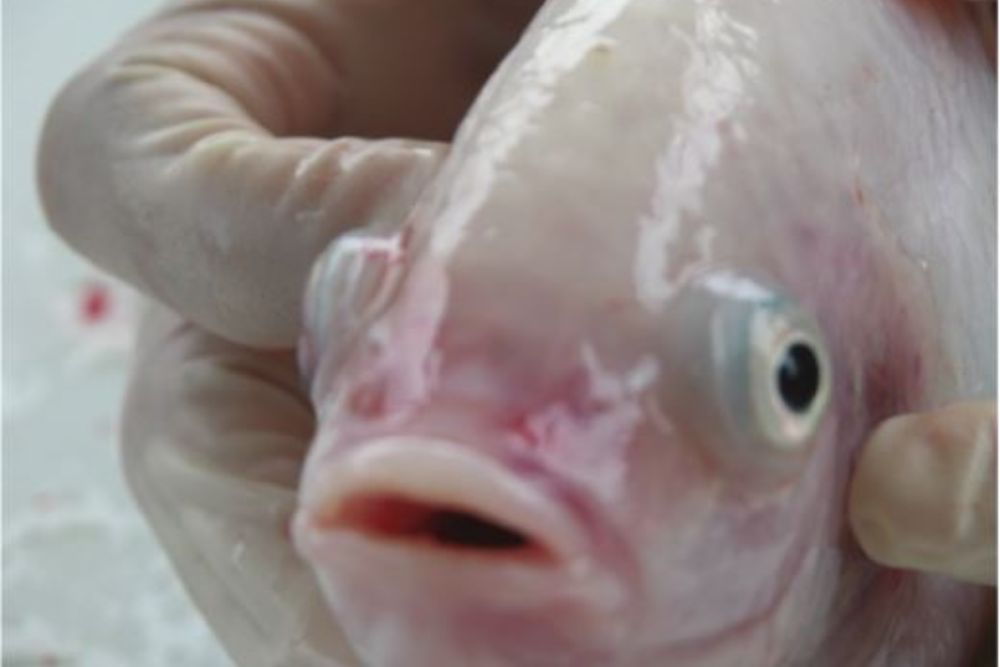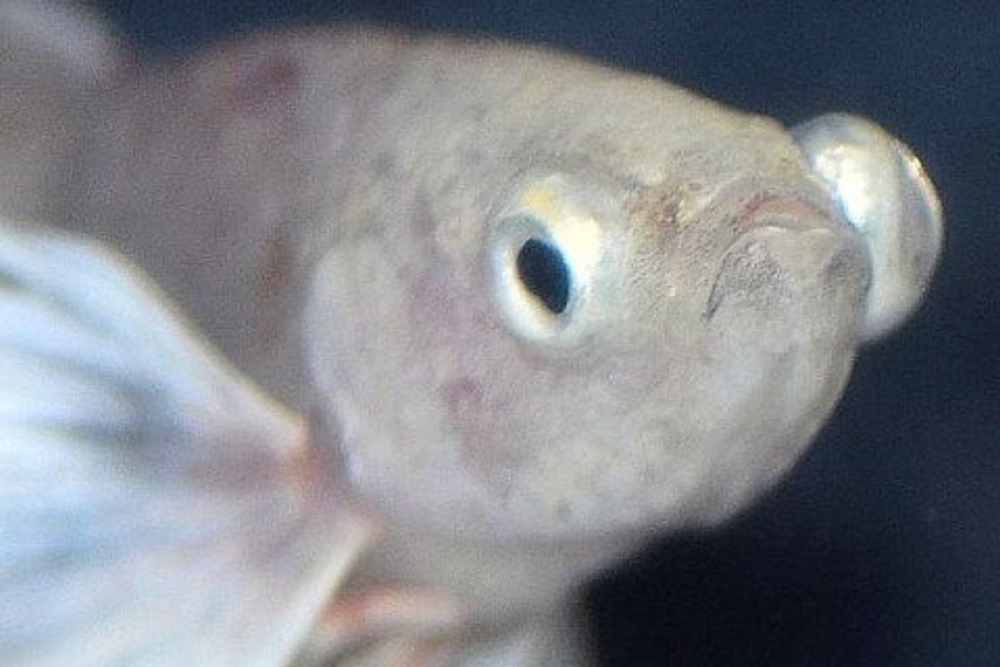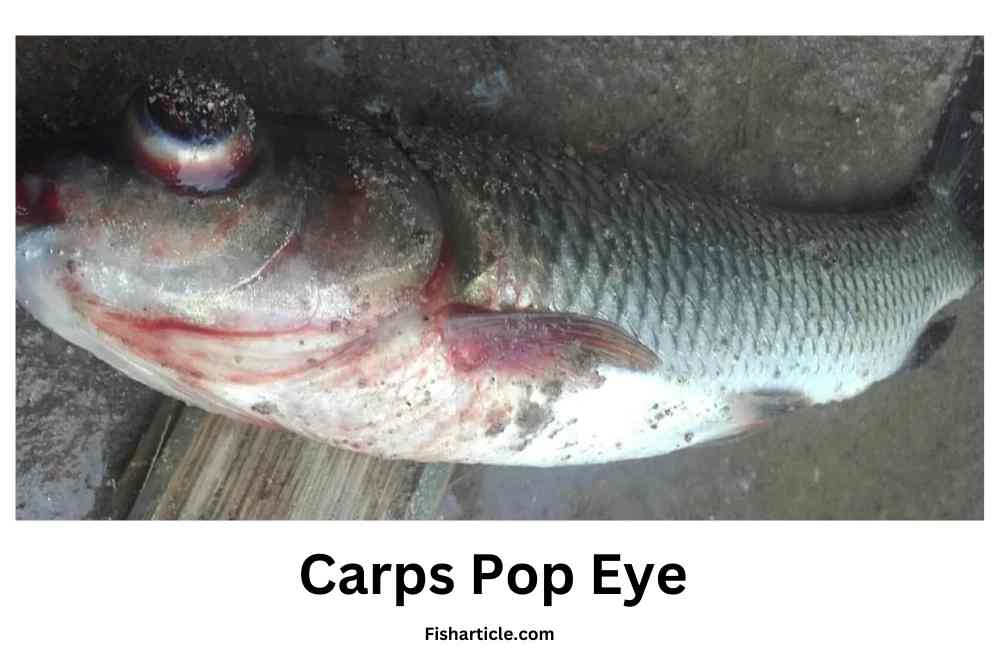Popeye fish (Exophthalmia) is a condition that causing fish’s eyes to become enlarged and protruding from their heads. This condition is caused by a variety of reasons, such as bacterial and viral infections and supersaturation of environmental gases.
Symptoms of the condition include cloudy bulging eyes, lethargy, and loss of appetite. Treatment includes a combination of antibiotics and good husbandry practices.

What is Popeye in Fish
Popeye is characterized by the swelling of the fish’s eyeballs and can be caused by a number of different factors, including poor water quality, pathogenic infection, stress, and injury.
It causes the eye to swell up and stick out from the body. Basically, It is a bacterial infection that affects fish.
The bacteria enter through the fish’s gills and multiply rapidly, causing inflammation and swelling of the head and body.
What Causes Popeye (Exophthalmia) in Fish
1. Bacterial Infections
One of the most common causes of Popeye in fish is a bacterial infection. Pathogenic bacteria, such as Aeromonas and Pseudomonas, can enter the fish’s eye through injuries or abrasions on the eye’s surface.
Once inside, these bacteria can multiply and cause inflammation, leading to the swelling of the eye. Bacteria produces a toxin that damages the fish’s eyesight. This makes it difficult for the fish to feed or swim correctly, which can lead to death.
Popeye is a condition that results when fish are infected with enteric red mouth disease.
This disease is caused by a bacteria called Enterobacter Yersinia ruckeri, which is found in contaminated food or water.
Salmonid fish enteric red mouth disease (ERM) is an acute septicemic bacterial illness of salmonid fish species caused by Yersinia ruckeri, a Gram-negative rod-shaped enterobacterium.
2. Viral Infection
Viral hemorrhagic septicemia (VHS) is a deadly virus that affects fish. VHS can also cause exophthalmia, or Popeye, in fish. This condition results in the swelling of the eyes, and can eventually lead to blindness.
The virus is spread through contact with contaminated water, and can cause severe bleeding and death in fish.
3. Parasitic Infections
Some parasitic infections can also result in Popeye. Parasites like flukes or protozoa can attach themselves to the eye tissues, causing irritation and inflammation.
4. Physical Trauma
Physical injuries to the eye, such as being scratched by sharp objects in the tank or during aggressive interactions with other fish, can lead to Popeye.
These injuries create an entry point for bacteria or parasites to infect the eye.
5. Gas Supersaturation
Gas supersaturation in water can indeed be a contributing factor to cause this problem in fish, although it’s not a direct cause.
Gas supersaturation occurs when water holds more dissolved gases, such as oxygen and nitrogen, than it can normally support at a given temperature and pressure.
This phenomenon can lead to the formation of gas bubbles within a fish’s body, which can potentially affect its eyes and other internal organs.
If particles accumulate behind the eyeballs, these bubbles can be responsible for Popeye. These air bubbles could be the source of the nickname gas “Popeye.”
6. Internal Injuries
Popeye is usually seen in both eyes. Fish infected with this condition usually suffer from internal problems. Such problems include kidney failure and a metabolic disorder.
7. Nutritional Deficiencies
Inadequate nutrition, specifically a lack of essential vitamins and minerals like vitamin A, can weaken a fish’s immune system and make them more susceptible to infections and eye-related problems.
Signs & Symptoms of Fish Popeye (Exophthalmia)

Popeye’s disease is an disorder that affects the muscles that control the movement of the eyeballs. This disease affects one or both of the fish’s eyes.
–Gas bubble form in the blood and visible on external surfaces of the skin and in the oral cavity and eye sockets of fish.
–The most popular symptoms identified were swimming in isolation prior to erratic behavior and refusing to eat.
-Fish Eyes having severe infections may contain high concentrations of fluid. Eye problems, such as corneal opacity or cloudiness, were seen.

Diagnosis of Fish Popeye (Exophthalmia)
Diagnosing popeye in fish can usually be done through visual observation of the fish’s eyes and behavior. Here are some steps to diagnose popeye in fish:
1. Observe the fish’s eyes
Popeye in fish is characterized by swollen, protruding eyes that may appear cloudy or discolored. The affected eyes may also have a bulging appearance and may appear to be popping out of the fish’s head.
2. Check for other symptoms
In addition to swollen eyes, popeye in fish may also be accompanied by other symptoms such as lethargy, loss of appetite, and abnormal swimming behavior. The fish may also exhibit signs of distress or discomfort.
3. Examine the aquarium environment
Poor water quality, high ammonia or nitrite levels, and overcrowding can contribute to the development of popeye in fish. Therefore, it’s important to check the water parameters in the aquarium, including temperature, pH, ammonia, nitrite, and nitrate levels, and ensure that they are within the appropriate range for the fish species.
4. Rule out other diseases
Some other fish diseases, such as bacterial or fungal infections, can also cause symptoms similar to popeye. Therefore, it’s important to rule out other diseases by considering the overall health of the fish, checking for any other visible signs of illness.
Some common molecular techniques used in the examination of popeye in fish may include:
5. Polymerase chain reaction (PCR) & DNA sequencing
PCR is a laboratory technique used to amplify specific segments of DNA or RNA from a sample. It can be used to detect the presence of pathogens, such as bacteria or viruses, in the fish’s eye tissues.
PCR can also be used to identify specific genes or mutations that may be associated with popeye in fish.
DNA sequencing is a technique used to determine the sequence of nucleotide bases in a DNA molecule. It can be used to identify specific genetic mutations or abnormalities that may be contributing to the development of popeye in fish.
6. Gene expression analysis
Gene expression analysis involves measuring the levels of gene expression in the fish’s eye tissues.
This can help identify any changes in gene expression patterns that may be indicative of underlying factors contributing to popeye, such as inflammation or immune response.
7. Microbiological culture and identification
Microbiological culture involves isolating and growing microorganisms from a sample, such as eye tissues, to identify the specific pathogens that may be causing popeye in fish.
This can help determine the appropriate treatment options, such as antibiotics or antifungal agents.
How To Prevent Popeye Disease (Exophthalmia)
It is important to prevent the spread of the virus by practicing good hygiene and keeping fish tanks clean.
Properly Measure the Gas Concentration
If you keep fish as pets, you know that they need clean water to stay alive. But did you know that the quality of the water is just as important as the quantity? One water quality issue that is often overlooked is gas concentration.
Many factors can affect gas concentration in aquariums and ponds, including temperature, filtration, and aeration. If the levels are too high, it can be fatal for your fish.
Properly measure the gas concentration. This can be done with a simple test kit from your local pet store. Once you know the levels, you can take steps to adjust them as needed.
Temperature is one of the biggest factors affecting gas concentration. As water warms, it holds less dissolved oxygen and off-gasses more carbon dioxide.
Proper Monitoring of Water & Partial Water Change
Monitoring the aquarium water chemistry and observing your fish daily can help you avoid this disorder.
Replacement of cloudy water with clean water should be helpful for maintaining proper water quality.
However, if the tank is well maintained, partial water changes are performed regularly, and the fish are fed nutritional food, the odds of Popeye striking are greatly diminished.
Proper Feeding Management
Popeye is caused by improper feeding or too much ammonia in the water. It could also be due to bacteria or other diseases.
To prevent Popeye, you should monitor the pH level of the water and feed the fish properly. You must maintain the proper amount of ammonia in the water.
Popeye (Exophthalmia) Fish Treatment
How to treat Popeye in farm and aquarium fish are given below,
Degas Water
A fish culturist whose water source is saturated with inert gases may use many different types of gas release devices to release the gas from the affected water.
Usually, agitation of the water is necessary. Devices used are for releasing the oxygen in the water (aeration) can be used to degas water.
Test Water Quality
Test the water in the tank before adding new fish. Make sure that the pH level and temperature are within the accepted range for your fish.
Daily water changes are essential to maintain safe conditions for the other fish in the aquarium.
Using Epsom Salts
Epsom salt is useful for treating inflammation, swelling, and infections. Salt should be left alone for about ten minutes.
It is suggested to use either Epsom salt or aquarium salt to treat popeye. Epsom salt is gentler on fish than aquarium salt.
How much salt do I add to treat popeye disease?
For the salt treatment, he should be left in the saltwater for about 5-8 minutes. Fish should be moved to a separate tank before being treated with salt.
Antibiotic Treatment
Antibiotics treatment or antifungal medications are effective against fish eye infections. Antibiotic medications are administered orally.
Broad-spectrum antibiotics are given to treat internal infections. The dose required can vary depending on the type of antibiotic used and the severity of the infection.
Quarantine the Infected Fish
Remove the infected fish from the aquarium. Place them in a separate hospital/quarantine tank with optimal water conditions (temperature, pH, hardness). Do not put them back together again.
Stop Overfeeding
Fish should never be fed live foods because it could cause an infection. For ensuring a healthy immune system, high-quality feeds should be given to the fish.
Use live foods such as brine shrimp, daphnia, bloodworms, and mosquito larvae.
Tips for Fish Popeye Disease in Aquarium
- Make sure you give the fish enough space to swim around.
- Keep the water clean and avoid adding too many plants or decorations.
- Make sure your water is healthy, and not too acidic or alkaline. Don’t use over-the-counter products without consulting an expert.
- Avoid rough handling of fish. Keep fish away from sharp objects.
Frequently Asked Questions (FAQs)
How serious is Popeye disease?
Popeye disease is a serious and often fatal illness. In recent years, Popeye disease has become more prevalent in fish.
Does Popeye in fish go away?
The good news is that in most cases Popeye can be treated successfully the Popeye in fish go away within a week. Treatment may include antibiotics if the cause is bacterial, antiviral medications if the cause is viral, improving water quality, and/or removal of any toxins from the environment.
Is Popeye in Fish Painful?
Fish may be able to sense when they are injured and stressed that’s why the reduce feed intake and normal body movement.
Can Popeye Kill Fish?
Popeye is a symptom of fish internal disease, it can create blindness and kill fish.
Can a fish recover from Popeye?
There is no one definitive answer to this question as to the severity of Popeye, and a fish’s ability to recover from it depends on a variety of factors. In general, however, most fish can overcome the disease if they are given proper care and treatment.
In some cases, it may also be necessary to supplement the fish’s diet with vitamins or medications. With patience and diligent care, most fish will eventually make a full recovery from Popeye.
Is there any need for fish Popeye surgery?
No need, proper treatment may reduce the swelling eye condition
References
- Marsh, M. C. (1903). A fatality among fishes in water containing an excess of dissolved air. Transactions of the American Fisheries Society, 32(1), 192-207.
- Barham, W. T., Schoonbee, H., & Smit, G. L. (1979). The occurrence of Aeromonas and Streptococcus in rainbow trout, Salmo gairdneri Richardson. Journal of Fish Biology, 15(4), 457-460.
- Bjornsson, B. (2004). Can UV-treated seawater cause cataract in juvenile cod (Gadus morhua L.)?. Aquaculture, 240(1-4), 187-199.
- Marking, L. L. (1987). Gas supersaturation in fisheries: causes, concerns, and cures (Vol. 9). US Department of the Interior, Fish and Wildlife Service.
6 thoughts on “Popeye Fish Disease: Causes, Symptoms & Treatment”
Comments are closed.